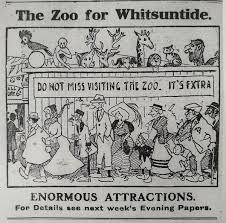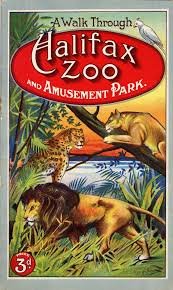The guest speaker was Christine Leveridge, a local historian and deltiologist - a person who collects and studies postcards as a hobby. Her subject was Halifax Zoo. A show of hands from the audience indicated that not all our members were aware of such an attraction.
Christine said that her ‘specialist subject’ was the July 1912 visit of King George the fifth and Queen Mary to the West Riding of Yorkshire. While Christine was researching the visit, she became aware for the first time of Halifax Zoo. One of the articles she read informed the public that the royal party would include the zoo in their visit, and that members of the public who went to see them would be issued with a flag coloured either red, white, or blue to wave when they saw the king and queen making their way to the zoo.
She advised that much of her presentation would include advertisements and images of the time, which would not be used today without causing offence to some people – and apologised in advance if that would be the case for anyone present.
Using a map created in 1907, Christine described where Halifax Zoo was situated – in an area known as Chevinedge in Exley, still a district of Halifax. She used a once well-known, but recently demolished pub at Salterhebble, Halifax to help us get our bearings. The site of the zoo is now almost totally changed and part occupied by Siddal Rugby Club. There is a bus service from Halifax to where the zoo once stood.

Residents of Halifax may first have learned about the zoo in February 1909, when the Halifax Courier reported that part of the Chevinedge Estate had been transferred to a company that would build an up-to-date zoo and amusement park. Christine said that Mr Alfred McKill was involved in the project. He had tried, unsuccessfully, to create a similar project at Roundhay Park in Leeds. There was no formal opening of Halifax Zoo, but the first time it opened to the public was at 2pm on Saturday the 29th of May 1909. The zoo had forty thousand visitors on that weekend. Attendances for the Friday, Saturday and Monday of Whitsuntide that year totalled over twenty-one thousand people.
All the building work was done by local companies, and photographs of the park were provided by Lilywhites, of Halifax. Christine’s slides included buildings and areas of Todmorden, including the Abraham Ormerod Clinic, now demolished and the site occupied by an Aldi supermarket.
An ex-mansion house on the zoo site was adapted to cater for the visitors, and there were several kiosks on the site selling programmes, chocolates and sweets for the visitors, plus penny packets of biscuits and nuts to feed the animals. A section of this house is the only building from the Halifax Zoo still visible today.
The pioneer attraction on the site was the Electric Theatre; the first cinema, or Picture Palace, built outside London, and also containing ‘test your strength’ machines and similar, opening on Christmas Eve 1909.

There was a firework display every evening at dusk, probably appreciated much more by its visitors than the animals. The firework displays were cut to Mondays and Tuesdays only in 1914. There were also local brass bands, including one which represented the zoo. The bandstand on site was decorated with flowers grown in the greenhouses near to the mansion.
Christine pointed out that this entertainment took place while elephants were led through the park, mingling with the crowds for the 12 hours – 10am to 10pm each day the zoo was open. We saw a slide of one of the female elephants, which had been bought from a zoo in Glasgow by Mr Alfred McKill. The animal was thought to have been intended for a zoo to be built at Roundhay Park, Leeds.
However, this project was abandoned, so elephant and handler came to Chevinedge. The elephant didn’t settle well at her new home and one night broke free from her chains and escaped into the grounds. Her handler, a man called John Aaron, was summoned and found the elephant asleep on the lawn in front of the mansion on site. She calmed down after some time and later walked along roads in the area as a travelling billboard advertising Halifax Zoo.
Christine showed us some of the advertisements of the time, including ‘Admiral Underwear – guaranteed unshrinkable’, and a draper’s shop offering goods which were ‘passementerie’. None of the audience came up with what the term meant – the art of making trimmings for clothing and furnishings – better known as tassels. Then a local company called Dentons, providing wooden furniture with the slogan ‘If you want a happy day, go to the Halifax Zoo., If you want to be happy all of your lives – go to Dentons’. Less cheerful was an appeal from Mr John Thompson, a licensed slaughterer who was seeking five thousand horses for his trade.
In a similar vein, we heard about the conditions in which the animals were kept. All the cages and buildings were made of white glazed bricks and tiles and had concrete floors. The bear cages were separated from the visitors by a single horizontal steel bar and, not surprisingly, two occupants; a Canadian grizzly and a Russian bear escaped from their cage in 1913. The Russian bear was quickly captured, but the grizzly bear wandered around for an hour and a half before being returned to the zoo.
Visitors to the zoo could have seen camels, zebras, monkeys - kept in a prominent monkey-house, many birds including black and white swans and ducks from China, Indian pythons and eagles among its animals. Demonstrations of lion taming were part of the entertainment, and a herd of deer from China could be seen at one side of the mansion in company with peacocks and turkeys. Four polar bear cubs were born and reared in Halifax Zoo in 1909, and arctic and Russian foxes were on show.
Christine told us about an incident involving an unnamed visitor who was said to be teasing a wild boar which was enclosed by wooden railings. The boar was said to have gone into a frenzy and seized the leg of the visitor, but let go after being struck by an umbrella a few times by another visitor. This showed that people didn’t fully appreciate that the animals weren’t all tame, and many of them were actually dangerous. Other reports mentioned visitors with sticks who poked other caged animals with umbrellas and sticks, causing wounds.
Christine had been unable to find details of the closure of Halifax Zoo, other than it happened in 1916. This was halfway through the Great War, and reasons might have been a lack of interest, increasing costs to keep the animals and, of course, the war effort at home and abroad. The animals may have been sold, or just passed onto other zoos such as Belle Vue, Manchester. The one reference, or reminder of the Halifax Zoo today can be found at a pub called the Meandering Bear, in the town centre.
Our members enjoyed the first guest speaker of 2025, who provided an absorbing and interesting talk.